Click on picture icon to see more!

Corfu is one of the Greek islands, and is called Kerkyra as well. It has a
capital by the same name.
It is called "green island" - there's really alot of green plants,
if you compare it with continental Greece. The humidity of the air there is quite high.
Corfu is located in the western part of Greece, close to the Albanian border.
Most of the Greek Islands are located in the Aegean sea, while Corfu is in the
Ionian sea.
All the people we met were very nice to us.
Click on picture icon to see more!

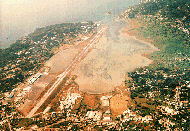 Aerial
photograph taken in the time when we were waiting for getting the permission
to land. As you can see, the airplane must approach from the sea. The runway
is 2375m long, with water on the left, water on the right and highway at one of
its end... We were told that the airplane captains must have special training
before they are allowed to land there. I don't know if this is true, but I can
say it's really amazing when they have so much control over their machines!
Aerial
photograph taken in the time when we were waiting for getting the permission
to land. As you can see, the airplane must approach from the sea. The runway
is 2375m long, with water on the left, water on the right and highway at one of
its end... We were told that the airplane captains must have special training
before they are allowed to land there. I don't know if this is true, but I can
say it's really amazing when they have so much control over their machines!
 A cliff not
far from the place where I lived. I lived on the northern coast in
Agnos/Karrousades. This cliff is on a way to Roda (east from Agnos when going
on the beach)
A cliff not
far from the place where I lived. I lived on the northern coast in
Agnos/Karrousades. This cliff is on a way to Roda (east from Agnos when going
on the beach)
We tried to go to Roda on our very first day, but we ended up in a place that
was full of weeds and thick bushes with thorns, which prevented us from going
further. The next time, we tried to get there by a road, and just short of
Roda, the road went across a small bridge. There were tourists leaning over
the railing and throwing pieces of bread into the puddle below. We thought -
they are feeding the fishes! But there weren't any fishes, there were turtles.
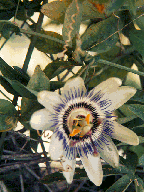 I found
this flower on a fence as I went on a road to Roda. In our language, it is
called "Mucenka" ("Passiflora" in Latin).
I found
this flower on a fence as I went on a road to Roda. In our language, it is
called "Mucenka" ("Passiflora" in Latin).
As Central Europeans, we were dazzled by the number of tropical plants growing
there without too much effort, while back at home they are hard to grow even
in a greenhouse.
Let's name a few of them: olives (olives were everywhere), opuntia, fig tree,
banana tree, lemon tree, orange-tree, eucalyptus, almond tree.
We were told that Corfu produces 2% of the world's production of olive oil!
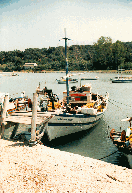 When we
went west from Agnos along the beach, we came across a small restaurant
offering fresh fish. This "Three brother's" boat probably belongs to
the restaurant's owner, as it bears the same name.
When we
went west from Agnos along the beach, we came across a small restaurant
offering fresh fish. This "Three brother's" boat probably belongs to
the restaurant's owner, as it bears the same name.
Once at this restaurant, we sat down under a green "roof" of
grape-vines. We ordered Greek salad. You can prepare it at home. All you need
is tomatoes, cucumber, green pepper, onion, feta cheese, black olives, salt,
pepper, vinegar, and olive oil.
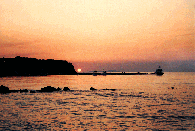 Once, as I
was returning from an "on foot" trip around the Agnos neighbourhood,
I noticed the sun going down under the sea. I could not resist taking a
picture. I had 100 ASA film, so I had to improvise a little bit to avoid the
camera shake.
Once, as I
was returning from an "on foot" trip around the Agnos neighbourhood,
I noticed the sun going down under the sea. I could not resist taking a
picture. I had 100 ASA film, so I had to improvise a little bit to avoid the
camera shake.
The beach was almost deserted, with only a few pedestrians passing by,
watching the same romantic scene as I did.
 Small
houses in the olive grove.
Small
houses in the olive grove.
Olive trees could be found just about everywhere. In the past, the island had
been ruled by the Englishmen. Venetian brought the olive trees to Corfu.
The peasants were paid a gold coin of considerable value for each planted
olive tree. Other trees
became extinct because of extensive exploitation for ship construction.
Olives are harvested during the winter - it's rainy during that part of the
year. First, the grass below the trees is cut. Then, the ground is covered
with wide stripes of black plastic net. Over time, the olives fall onto the
net and people sweep them for storage.
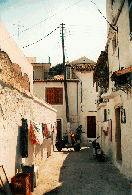 Paxos is a
small island to the south from Corfu. There's another even smaller island on
the South from Paxos, called Antipaxos, but our boat went only to Paxos. Here is a back street
in Paxos. I would call this "Greek still-life"...
Paxos is a
small island to the south from Corfu. There's another even smaller island on
the South from Paxos, called Antipaxos, but our boat went only to Paxos. Here is a back street
in Paxos. I would call this "Greek still-life"...
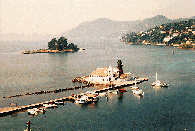 You can
find this view on a majority of Corfu postcards. If I remember it well, this
place is called Vlakheros and it serves as a monastery.
You can
find this view on a majority of Corfu postcards. If I remember it well, this
place is called Vlakheros and it serves as a monastery.
The island in the back (on the left) is called Pontikonosi (The Mouse Island).
From the very same place, from which this picture was taken, you can watch the airplanes landing and taking off.
 This is one
of the 7 monks who live in the monastery located on the hill above
Paleokastritsa town. As far as I know, monks shouldn't smoke - this one tries
to hide away the cigarette in his hand. - Can you see any cigarette? No!
This is one
of the 7 monks who live in the monastery located on the hill above
Paleokastritsa town. As far as I know, monks shouldn't smoke - this one tries
to hide away the cigarette in his hand. - Can you see any cigarette? No!
In the meantime he let the tourists take pictures of themselves sitting next
to him. This definitely wasn't what I imaginged to be a monk's life. Well, the
guide had told us, that Corfians make their living on tourist traffic.
 Another
monk from the same monastery. Here, he doesn't want to be photographed,
although he is already on a postcard dedicated to this place.
Another
monk from the same monastery. Here, he doesn't want to be photographed,
although he is already on a postcard dedicated to this place.
You can see children pointing their fingers in my direction - they revealed my
presence to him.
I'm sorry, but the monk should have said something sooner!
 A back
street in Corfu town, with clothes hanging across the street, a blackboard with a
restaurant's menu, and the small boy. It's a kind of romantic place, isn't it?
A back
street in Corfu town, with clothes hanging across the street, a blackboard with a
restaurant's menu, and the small boy. It's a kind of romantic place, isn't it?
Unfortunately the film was unable to express the richness of the shadows and
lights - some moments are hard to capture by any means!
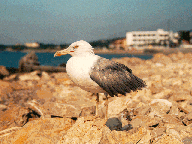 Seagull on
Agnos beach... he was a little bit afraid of me, but in the end, he let me
approach to him half meter away. I talked to him, explaining why he should
wait for a while. He seemed to understand.
Seagull on
Agnos beach... he was a little bit afraid of me, but in the end, he let me
approach to him half meter away. I talked to him, explaining why he should
wait for a while. He seemed to understand.
Have you noticed the same dark orange colour around his eyelids and on his
beak? What a fascinating designer Mother Nature is!
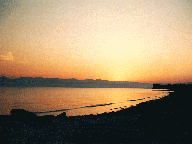 This is
the very last sunrise that I saw on Corfu. The air was quite clean and dry, so
the Albanian coast was clearly visible. The Albanian coast is about 2 km away
from the Agnos coast, and you can see the Albanian shores if the fog is not
too thick.
This is
the very last sunrise that I saw on Corfu. The air was quite clean and dry, so
the Albanian coast was clearly visible. The Albanian coast is about 2 km away
from the Agnos coast, and you can see the Albanian shores if the fog is not
too thick.
I guess I don't have to tell you that I would have stayed there longer, if it
would have been possible.
Beach sand from Agnos I took some sand from the
beach to Prague, where I've used it as a bed for a photo of shells.